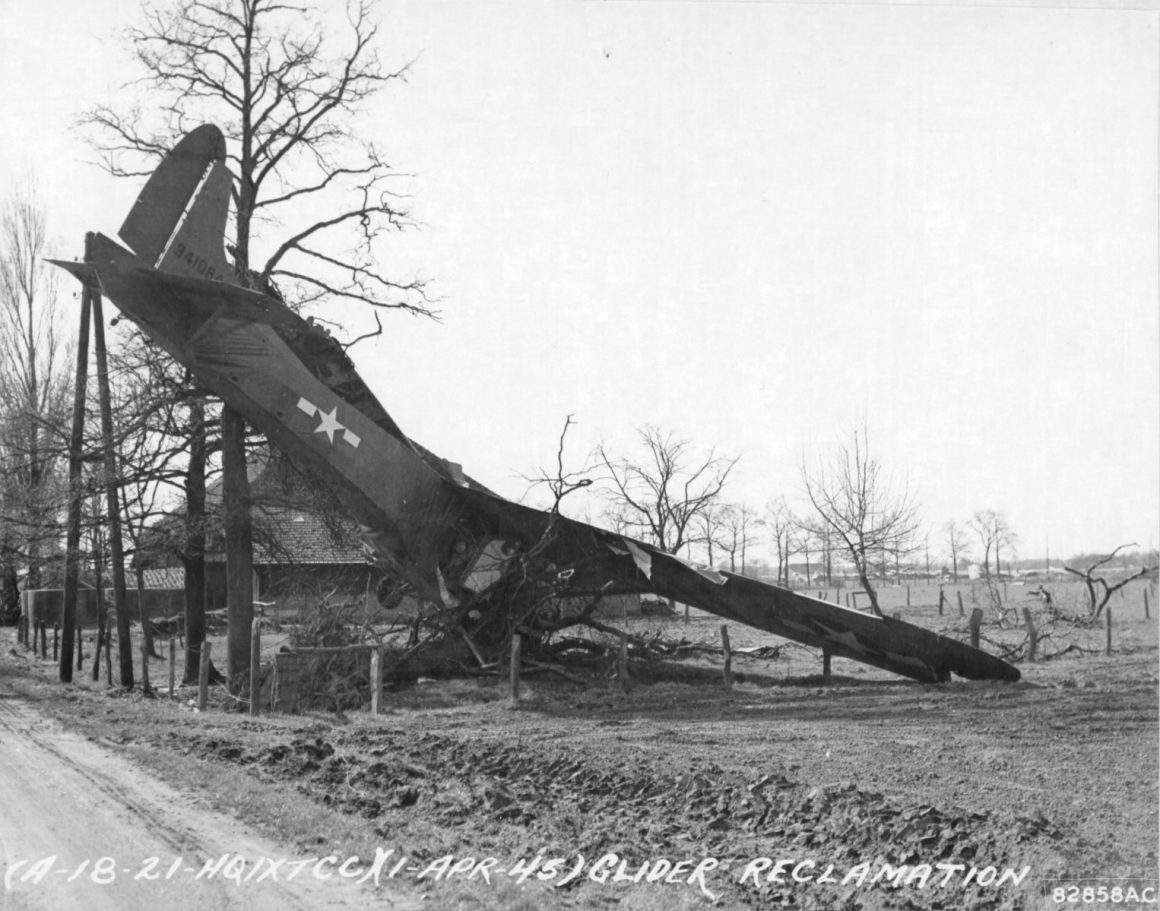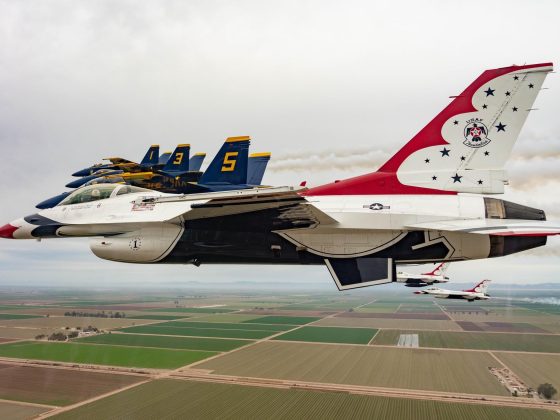The CG-4A Carried Much More Than Just Troops Into Battle
Waco’s CG-4A cargo glider, nicknamed the Hadrian by the Brits, carried approximately 50 percent of any Airborne Division’s paratroopers into battle during World War II. The 82nd Airborne Division Eighty Deuce, the 101st Airborne Division Screaming Eagles, and the 17th Airborne Division Golden Talons all utilized cargo gliders to deliver paratroopers and much of their equipment to the battlefield. The cargo gliders were force multipliers, not quite doubling the payload of the transports towing them into action. Most CG-4As were towed behind Douglas C-47 Skytrain transports, but Curtiss C-46 Commando transports were employed as glider tugs in the European Theater of Operations (ETO) after March of 1945 and Lockheed C-60 Lodestars were capable of towing lightly-loaded CG-4As into the blue.

Carrying the Army’s Heavy Gear to War
Loading of the CG-4A was completed via an upward-hinged nose section (including the pilot’s and copilot’s seats and flight controls). And load the CG-4A they could with 13 troops and their equipment, or up to 6 litters of wounded men, or other loads including such diverse cargo as a 75 millimeter howitzer, a 37 millimeter anti-tank gun, a Jeep, a weather station, a field kitchen, radar or radio equipment, a mobile repair shop, a small bulldozer, and even a complete photographic laboratory.

When Building a Glider, Make It Light and Cheap
The CG-4A was designed to be light and to be built quickly, inexpensively, and be easily assembled at the airfields from which they would be towed into battle. The design featured straight strut-reinforced and shoulder mounted high-lift wings totaling 900 square feet in surface area, a conventional empennage, and fixed twin main and single tail wheels. The fuselage structure consisted of steel tubing and the wings contained wooden frames. The entire structure was fabric-covered.

They Were Bigger Than You Think
The crew of two, consisting of a pilot and co-pilot, flew the Hadrian into battle at speeds around 100 miles per hour (depending on the tow aircraft- VNE was 150 miles per hour) and at weights up to 8,000 pounds. Measuring 48 feet 8 inches in length with an 83 foot 8 inch wingspan, the CG-4A fit somewhere between the Lockheed C-60 Ventura and the Douglas C-47. The CG-4A could take as little as 600-800 feet to land safely (when lightly loaded) but often required up to 3,000 feet when loaded to capacity.

Before You Can Fight You Have to Train
Construction of the first CG-4A began in 1941, with initial flights commencing in May of 1942. To produce glider pilots, The US Army Air Forces activated Sedalia Glider Base near Knob Noster in Missouri on 6 August 1942, renaming the base Sedalia Army Air Field (AAF) in November of the same year. There the 12th Troop Carrier Command trained glider pilots and copilots along with the paratroopers who would ride into battle with them. Sedalia AAF also trained Curtiss C-46 Commando and Douglas C-47 Skytrain crews to tow the gliders. In 1955 Sedalia AAF became Whiteman Air Force Base (AFB).

Building Gliders in Furniture and Refrigerator Factories
From 1942 until the end of the war in 1945 13,903 CG-4A gliders were built. The Ford Motor Company plant in Kingsford, Michigan, built 4,190 of them, making them the largest but certainly not the only CG-4A production facility. Fifteen other contractors ran 24-hour shifts to build the gliders, including Babcock Aircraft Company in DeLand, Florida, Cessna Aircraft Company in Wichita, Kansas, Commonwealth Aircraft in Kansas City, Missouri, G&A Aircraft in Willow Grove, Pennsylvania, General Aircraft Corporation in Astoria, New York, Gibson Refrigerator in Greenville, Michigan, Laister-Kauffman Corporation in St. Louis, Missouri, and Ward Furniture Company in Fort Smith, Arkansas to name a few.

Into Action in the ETO
CG-4As first saw action in July of 1943 during the Allied invasion of Sicily. Flown 450 miles across the Mediterranean from North Africa, they took part in night-time assaults such as Operation Ladbroke. The next major operation in the European Theater of Operations (ETO) that employed the CG-4A was Operation Overlord– the American airborne landings in Normandy on 6 June 1944. The CG-4A was smaller than the British Airspeed Horsa cargo glider and was able to land in smaller spaces. The majority of the CG-4As that landed successfully were either abandoned in place or destroyed. Hadrians also saw combat during Operation Market Garden and every subsequent airborne assault in the ETO. They were even used to deliver supplies and munitions to partisans in Yugoslavia.

To War Against the Rising Sun
CG-4As also saw combat in the Far East against the Japanese. Seeing action in New Guinea to land engineers in remote areas and for rescues first, the gliders were also used to covertly insert (and then supply) US and British “Chindit” raiders behind Japanese lines in Burma. The Brits utilized CG-4As throughout the China Burma India (CBI) theater. CG-4As were also operated by the US Navy, designated LRW-1. The Royal Canadian Air Force also flew the Hadrian.

Interesting Endgame
Declared surplus after World War II concluded, most of the remaining intact CG-4As were sold off. Many of them were bought for the wood used in the large shipping boxes used to transport unassembled gliders to their assembly points. Still others were converted into towed camping homes by sawing off the wings and horizontal and vertical tail surfaces. They were then towed (backwards- by their tails) to the great outdoors. A few CG-4As even ended their days as lake side vacation cabins and hunting cabins. The final operational use of the CG-4A took place when the US Air Force utilized ski-equipped CG-4As to support scientific research into floating ice floes in the Arctic during the early 1950s.
There is one displayed at the US Air Force Museum in Dayton, Ohio. Avgeekery did a short video on the glider. You can view it here.

Avgeekery Honors The CG-4A Glider and Its Pilots at the Memorial Miniature Golf and Museum at Buda Texas
Avgeekery has sponsored a display at Memorial Mini Golf in Buda Texas. The mini golf course features 18 unique holes that tell the story of World War II. Avgeekery sponsors the hole depicting D-Day, the Longest Day. It features the longest hole in known miniature golf courses. Our contribution is a model of a Waco CG-4A glider.
Much like the real glider and it’s ability to move troops and supplies quicker, the model offers a short-cut for golfers to reach the hole with less strokes. We see it as a worthy way to honor the many glider pilots and paratroopers who flew aboard the mighty gliders that extended American and Allied power projection to turn the tide of the war in Europe and Asia.









